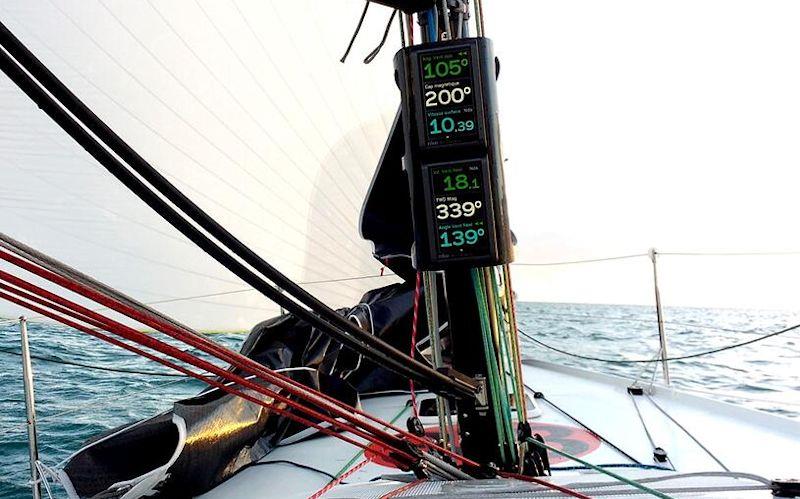
nke Depth and Speed sensors explained
by Aleix Escorsell 30 Jan 2020 17:00 UTC

nke Depth and Speed sensors explained © nke
The marine industry has been awash with new and exciting technological innovations in recent years and standing at the forefront are companies like nke marine electronics. nke are the standard for the majority of Mini-Transat and IMOCA 60 classes. They provide electronics for many different functions and for many different types of sailor.
You can find out more about the full range of nke products available on the upffront.com website.
This blog will focus on the nke speed and depth sensors. Good quality sensors are key to good autopilot performance, but location and water conditions are also factors in choosing the right sensors for your boat.
Depth Sensors
The nke Depth Sounder
The nke depth sounder can provide depth values in metres or feet depending on your preference. With a range of up to 50 metres, the nke depth sounder is able to give depth either from below waterline or below the keel depending on your preference.
Speed Sensors
All nke speed sensors can measure the speed that the boat is going and the temperature of the water, to varying degrees.
Paddle wheel speed sensor
The classic speed sensor, the paddle wheel speed sensor is a great choice for many types of sailors, for racing, cruising or offshore sailing. Reliable, cost effective and compact, this sensor will certainly prove more than adequate for the needs of most sailors. The biggest downside of the paddle wheel sensor is that weeds and other sea debris can occasionally get caught in the sensor and moving parts.
Ultrasonic Speed sensor
The Ultrasonic ends the problem of wheel blockage because it has no moving parts. It is a great choice for racers as the sensor is installed flush, meaning no drag. The ultrasonic technology allows anti-foul paint to be applied to the sensor, leaving it clean all season and cutting down maintenance. The Ultrasonic will also not need calibration as frequently as the other sensors. However, one slight downside of the ultrasonic speed sensor is that, in murky or dirty water, the ultrasonic sensor can lose a degree of accuracy.
Electromagnetic speed sensor
The electromagnetic speed sensor is the top of the range and gives highly accurate data in all waters, including with low visibility. It also has no moving parts and is a robust and compact device which will not create drag in the water and is unlikely to get caught on any weeds or other debris. This means that the electromagnetic sensor does not have either of the flaws of the other two sensors.
Which sensor should I choose?
There is not a great variation in performance from the three speed sensors listed above. The electromagnetic sensor and Ultrasonic sensor can measure temperatures of -10 to +50 degreesC, whilst the paddle wheel can measure 0 degreesC to +50 degreesC. All three sensors can measure speeds up to 35 knots. Another important consideration is weight.The paddle wheel sensor weighs 300g, compared to the Ultrasonic which weighs 550g.
For cruising and casual racing, the paddle wheel speed sensor will prove to be more than sufficient for the vast majority of sailors. It's cost effective and a great all-round speed sensor.
For professional sailors, it all depends on where you will be sailing. In waters with low visibility or high levels of sand, mud and other sediments, the electromagnetic sensor will be best suited to maintaining accurate results.
But, for the majority of competitive sailors sailing in clearer water, the ultrasonic speed sensor is accurate and reliable. It is the least vulnerable to fouling of the nke range of speed sensors and is also generally very low maintenance and a great choice!
Log / Sounder Interface
Regardless of which speed sensors you choose, you will need this interface to connect the depth and speed sensors to the topline bus. nke offers both single and dual log / sounder interface options, with the dual interface offering an additional slot for a second speed sensor. This is designed for boats such as multi-hulls and wide mono-hulls where one speed sensor would spend significant periods out of the water
Where should I position the sensors?
The placement of the depth and speed sensors depend on the type of boat you have.
On a sailboat, the ideal position for the sensors is in front of the keel, along the axis of the boat. The diagram below shows the proper positioning.
For motor boats:
It's important to line the sensor axis parallel to the centre (Lubber) line of the boat to ensure accurate calculations.
The sensors are fitted through the hull with a through hull fitting. These usually come with the sensor, but a replacement fitting can be purchased.
For more information on NKE and our range of electronics, Contact upffront.com using the contact form or if you are interested in looking at upgrading your boat navigation electronics complete the marine electronics requirements form.